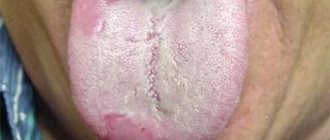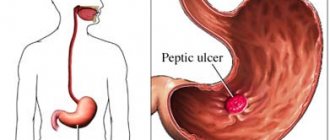The appearance of a yellow coating can signal the development of a serious disease, since the functioning of the digestive tract depends on the microflora on the tongue. Although the formation of yellow plaque is not always caused by pathologies.
There is always a coating on the tongue due to specific microflora. There are usually fewer bacteria at the tip because the mucous layer thins as food is chewed and swallowed. At the root of the tongue, the layer of microflora is much thicker, so yellowing is usually more noticeable in this part.
Yellow tongue in healthy people
In some cases, the appearance of yellow plaque has nothing to do with pathologies, but can be caused by the following factors:
- Smoking. Tobacco smoke contains substances that can kill bacteria. They are replaced by other microorganisms that have a different color. In addition, the tar contained in cigarettes can stain the mucous membrane.
- Frequent consumption of coffee or black tea. These drinks contain brown substances. They can stain the mucous membrane, but due to the thin layer it is yellow rather than brown.
- Consumption of certain foods. Chocolate, cocoa, some spices and other products can change the color of the mucous membrane. Turmeric can give the tongue a pronounced yellow color.
- Dyes and pigments. Natural and artificial colors used in soda and some foods can stain your tongue. Certain groups of vitamins and antibiotics have similar properties.
In summer, the cause of yellowing of the tongue may be a lack of water in the body. Sometimes it is enough to drink a couple of glasses of water so that the mucous membrane acquires a normal pink color.
Alarming symptom
If plaque is present in small quantities, the mucous membrane is visible through it, but there are no symptoms, there is no cause for concern. But it's important to remember that
a change in the color of the tongue may signal the development of pathology. You need to sound the alarm if deposits:
- not associated with drinking coffee, coloring products or smoking;
- cannot be removed;
- do not disappear after drinking water in hot weather;
- have an unpleasant odor;
- become darker and denser.
It is important to know that the plaque is always thicker in the morning, because at night it accumulates, since it is not washed with water and is not exposed to food. The formation of deposits in different areas of the tongue may indicate diseases of different organs.
What diseases cause a yellow coating on the tongue?
The following pathologies can cause the appearance of a yellow coating on the tongue:
- Intestinal infections. A yellowed tongue may be a symptom of diphtheria, salmonellosis or other acute gastroenterocolitis. Pathologies are accompanied by frequent and severe vomiting. Body temperature may also rise or other symptoms of poisoning may be present.
- Duodenogastric reflux. With this disease, food masses from the duodenum fall back into the stomach. The disease is also accompanied by severe heartburn, nausea, and pain under the right rib.
- Gastritis. Yellowing is clearly visible in the morning. Other symptoms include abdominal pain that gets worse after eating, nausea, and bloating.
Liver cirrhosis at the last stage: photos of people and liver
An unhealthy lifestyle and alcohol abuse lead to impaired blood flow in the liver vessels and blockage of the bile ducts. When malfunctions in the functioning of an organ become chronic, the structure of the liver tissue changes and it can no longer fully perform its functions. Toxic human waste products, bypassing the “filter”, enter directly into the blood, which leads to disruptions in the functioning of the entire body.
An irresponsible attitude towards your health will most likely lead to liver cirrhosis reaching a stage that is very difficult to treat. The last stage of cirrhosis is most often a death sentence for the patient, so in order not to go to extremes, you should not ignore the external signs of the disease. In this article, we will consider in more detail the symptoms of the disease in order to stop the destructive processes in the liver in time.
Symptoms of liver cirrhosis
Doctors call the last stage of the disease decompensation. It is characterized by complete replacement of liver cells with connective tissue, which leads to complete loss of working functions. Below are several photos of sick people who did not start treatment in a timely manner and cirrhosis has reached the last stage.
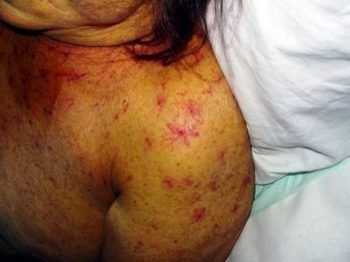
In addition to the unnatural color of the skin, spider veins are clearly visible in the photo.
With cirrhosis, the complexion first turns yellow, and then acquires a characteristic earthy tint.
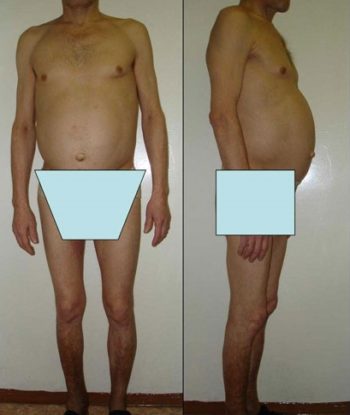
This photo shows the disproportion of the body and excessive thinness of the limbs.
The main symptoms include:
- general weakness;
- regular stomach upsets;
- a sharp increase in body temperature;
- severe swelling of the legs;
- tense ascites;
- the color of the skin acquires a yellowish tint;
- sudden weight loss and muscle atrophy in the upper body;
- frequent vomiting;
- bleeding, when bruises spontaneously form;
- the skin turns red and unpleasant itching appears;
- dilated veins that appear on the abdomen.
Having brought his body to such a state, a person cannot claim a long life path. But you can still fight for it if you immediately turn to doctors for help.
Read more about the most important symptoms in the last stage of cirrhosis
Most often, at the fourth stage of the disease, the following phenomena are considered important symptoms.
Tense ascites. Malfunctions of the liver and impaired blood flow lead to a build-up of fluid in the abdominal cavity, which is very dangerous for human life and can cause respiratory failure
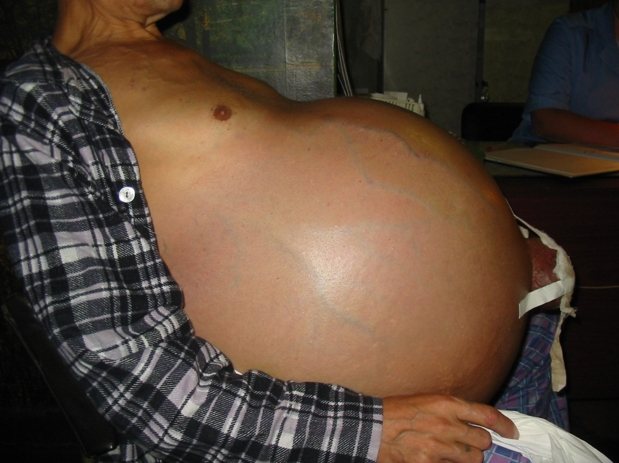
One of the main symptoms is a large belly with cirrhosis of the liver; it is clearly visible in the photo.
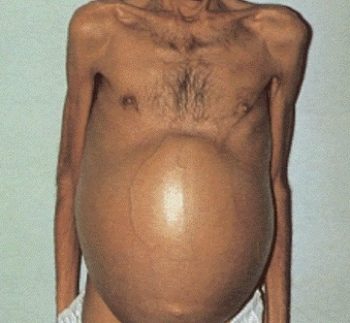
When cirrhosis of the liver is diagnosed at the last stage, photographs of people cannot convey even half of all the horrors of both external and internal changes. The patient simply melts before our eyes.
Varicose veins in the esophagus. Due to disruption of normal blood circulation, different tributaries are formed in the liver, causing the veins to become pathologically enlarged.

This network of veins is called the head of the jellyfish in liver cirrhosis. The photo clearly shows that the veins are greatly dilated.
Minor signs of illness
These symptoms are clearly visible and allow the doctor to make a primary diagnosis when examining the patient even before receiving test results. The pictures and photos posted in the article below will help you clearly understand the symptoms.
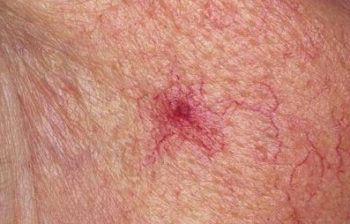
The upper body and face are densely covered with a capillary network. Spider veins on the body form in the form of spiders and can sometimes bleed, which is clearly visible in the photograph.
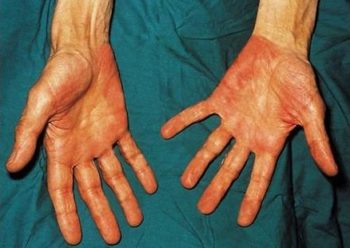
A clear sign is considered to be red palms in cirrhosis with characteristic hyperthermia. This redness of the palms is often called a symptom of beer lovers.
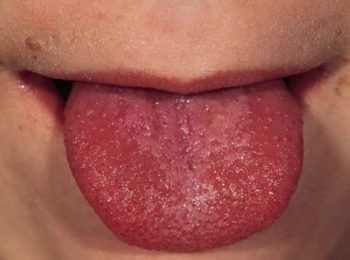
In addition to the hands, the tongue is colored lingonberry in case of cirrhosis of the liver. The photo shows obvious changes in the appearance of the tongue and its glossy shine, which indicates swelling. The color of the tongue in the early stages of cirrhosis may acquire a yellow tint and gradually reach the same state as shown in the photograph.

Our readers successfully use Leviron Duo to treat the liver. Seeing how popular this product is, we decided to bring it to your attention. Read more here...
In some cases, patients complain of itchy skin that simply drives them crazy. In terms of intensity, it can be compared with the itching of dermatitis at the acute stage or skin lymphoma. The only characteristic of itching is minimal or no rash. The cirrhosis rash in the photo looks like a normal allergic reaction, but this is far from true.
Doctors also often determine the color of stool in cirrhosis, which simply becomes discolored, while urine, on the contrary, darkens.
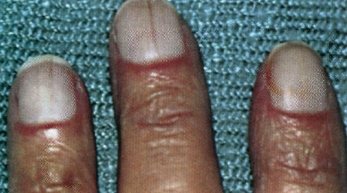
Often in patients diagnosed with cirrhosis, dilated capillaries can be seen on the nail bed. At the same time, it seems that splinters have been driven under the nails, which is clearly visible in the photograph.
Appearance of the liver with cirrhosis
We have already said that at the last stage of cirrhosis, the liver completely loses its functionality and is greatly modified. Due to the replacement of liver cells with connective tissue, the organ becomes overly dense, lumpy, with a rough surface and increases in size. As evidenced by the numerous autopsy photos that the Internet is replete with.
The photo clearly shows what the liver of a healthy and sick person looks like. And the fact that the external differences are simply amazing is an indisputable fact.
Preventive methods to prevent the development of cirrhosis include timely treatment of hepatitis and alcohol dependence. To avoid adding photos of people with cirrhosis to your face, just lead a healthy lifestyle and don’t forget to get checked so you can sleep peacefully!
Pathologies of the hepatobiliary group
If a yellow or yellow-green coating appears on your tongue, and there is a bitter taste in your mouth, you should not postpone a visit to the doctor.
Pancreatitis can cause a similar phenomenon. The symptom is especially pronounced in the acute form of the disease, when there is stagnation of bile. The pathology is accompanied by stool upset, abdominal pain, bouts of vomiting and other symptoms.
In liver diseases, the bilirubin content increases, which leads to staining of the mucous membrane. Most often, plaque on the tongue appears with cirrhosis or hepatitis. With cirrhosis, liver cells die, and connective tissue forms in their place, so the liver cannot cope with its functions. With hepatitis (inflammation caused by viruses or other factors), the mechanism of bilirubin absorption is disrupted.
Yellowing of the tongue, as well as other mucous membranes and skin, occurs due to inflammation or the formation of stones in the gall bladder or bile ducts.
Stain problem
Spots on the tongue in adults and children occur as a result of various types of diseases or malfunctions of internal organs. In order to apply certain means for treatment, the exact cause of the problems that have arisen is determined. To do this, an external examination of the tongue is performed. The nature of the spots can be varied.
They differ depending on the provoking problem in color, size, quantity and structure. A completely healthy person has no spots or wounds on his tongue. The surface of this organ is pale pink, slightly rough. The surface of a healthy person's tongue has a slight white tint. The appearance of spots indicates the opposite.
Large or small types of neoplasms, according to their external characteristics, indicate a problem. With these, a dense white coating may appear.
Plaque for gastritis - dense, in the center
We suggest that you familiarize yourself with Dental sinusitis - symptoms and treatment of odontogenic sinusitis
A sharp increase in the surface and structure of plaque often indicates poor oral hygiene or poor nutrition.
These 2 problems can be quickly solved with the help of: regular brushing of teeth, rinsing the mouth with special solutions and proper consumption of healthy foods. But if spots begin to appear on the tongue, it’s worth thinking about what this might be connected with. The reasons for their formation are varied. And if you cannot independently determine what the problem is, consult a doctor.
Other diseases
The appearance of yellowness on the tongue can be caused by respiratory diseases or dental pathologies. There are usually other symptoms, such as sore throat or mouth, increased body temperature, etc.
In some cases, deposits appear due to a deficiency of B vitamins. In this case, cracks may form on the surface of the tongue. If measures are not taken, over time the tongue will turn bright red.
If you suspect that yellow plaque is a symptom of a disease, or something else is bothering you. Be sure to consult a doctor and, if necessary, undergo a medical examination.
Visible veins under the tongue
Purple Veins Under the Tongue
Sometimes the purple underside of the tongue is caused by visible purple veins. There is nothing wrong, it is normal as long as the veins are not swollen and/or painful.
The sublingual veins tend to turn dark purple, blue, or blackish-purple if there is a reduced amount of blood flowing to the area.
This problem can occur at any age, including infants and older adults.
However, dilated, large, thick and clearly visible purple veins under the tongue under the tongue most likely indicate another disease - varicose veins. The manifestation of this pathology can even be on the tongue.
Oral diseases
Inflammatory processes in the oral cavity, including the tongue, do not always reflect the development of pathologies of internal organs - sometimes we are talking about independent diseases. If a burning sensation or the presence of a foreign body appears in the mouth, the tongue turns red and swells (the swelling tends to progress over time), salivation increases, taste sensations change (they may become dull or completely disappear), speech and eating become difficult, the patient feels pain in the tongue - these are symptoms of the development of glossitis, that is, inflammation of the tongue. This disease can take various forms, but the symptoms listed above are inherent in almost all of them.
How to identify a disease by tongue
Identifying problems in the body using the tongue serves as an informative diagnostic method. Thus, in the East, entire theories are devoted to the topic of how to determine a disease by language.
During the research process, attention is paid to shade, configuration, susceptibility and other characteristics. Manifestations on the tongue make themselves felt much earlier than other signs of illness.
https://www.youtube.com/watch?v=7Ym0VFTopBg
Therefore, language analysis is gaining more and more popularity.
Associated symptoms
In addition to changes in the color of the tongue, various diseases may cause changes in the structure of the tongue, taste sensations, shape, etc.
Changing shape
If the fold of the tongue is bent, then these changes may indicate cervical osteochondrosis. Most often it develops due to lack of mobility and a sedentary lifestyle.
If the fold changes its shape in the middle of the tongue, then this may indicate lumbar osteochondrosis. This disease is widespread among drivers.
Stains
If the tip of the tongue begins to turn red, this may indicate prerequisites for the development of coronary artery disease.
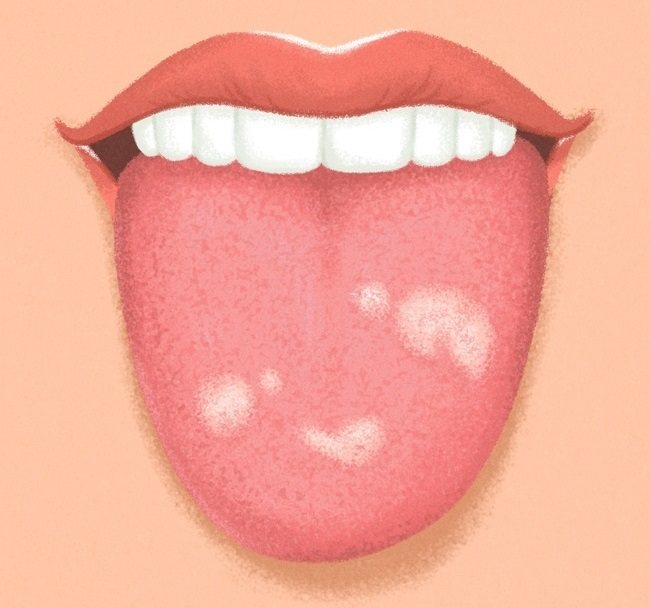
Bad breath due to hepatitis
One of the first signs of the fulminant form of hepatitis A is the smell of ammonia from the breath. It is present at all stages of the pathological process.
In the malignant form of other types of infection, the breath begins to smell like liver. The reason is impaired metabolism of the amino acid methionine. Because of this, methyl mercaptan, which has a liver odor, begins to accumulate in the body. The symptom indicates severe liver damage. In this case, other secretions of the patient may have a corresponding odor.
In addition to the unpleasant odor, bitterness in the mouth also occurs during illness. It indicates impaired liver function. Bitterness is characteristic of the chronic form of infection. You can feel it in the morning. A patient with hepatitis may also complain of distorted taste sensations. Some infected people can no longer distinguish the taste of sweet foods. Another sign of liver damage is tingling and burning of the tongue.
What are the types of liver diseases?
According to statistics, over 200 million people all over the planet have experienced liver disease at least once in their lives.
Problems with the filtering organ cause human death in every tenth case of death. In terms of mortality, hepatitis is equated to pulmonary tuberculosis and AIDS. Most often, liver diseases occur due to viral infections, intoxication with toxic substances, and alcoholic beverages. Chronic pathologies become a predisposing factor in the complete degeneration of organ tissue, cirrhosis.
Treatment
Treatment tactics depend on the cause of plaque on the tongue.
The doctor carries out therapy for the disease identified during diagnosis. The patient is prescribed treatment with drugs for oral and local use.
In some cases, physical therapy or surgery may be necessary
The result of therapy is an improvement in the patient's condition and the disappearance of brown plaque.
You should know! In addition to the prescribed treatment, the doctor gives recommendations:
- When brushing your teeth, be sure to brush your tongue using gentle movements from root to tip. You can use a teaspoon or the back of a toothbrush to clean your tongue. You need to brush your tongue and teeth at least 2 times a day .
- After each meal, rinse your mouth with specialized pharmaceutical solutions or herbal decoctions.
- Drink enough fluids and exclude fatty, fried and spicy foods from your diet.
- Stop smoking and drinking alcohol.
If during the examination a deficiency of vitamins or minerals was discovered, the doctor prescribes their intake in an individually selected dosage.
Correspondence of tongue zones to internal organs
To determine the state of health by the tongue, it should be taken into account that the tongue is conventionally divided into separate zones responsible for certain internal organs. When identifying pathologies, the doctor will first of all pay attention to the dislocation of changes in the tongue. An interesting fact is that from the point of view of ancient eastern practices, language is also divided into areas according to five “primary elements”:
We suggest that you familiarize yourself with Treatment of stomatitis at home and folk remedies
READ ALSO: burning in the mouth, burning tongue and lips: causes and treatment
- back - Water;
- central region - Earth;
- sides – Wood;
- between the tip and the central part - Metal;
- tip – Fire.
| Tongue area | Relevant authorities |
| Tip | Heart, small intestine |
| Sides | Liver, gall bladder |
| The area between the tip and the central zone (the transversely band-like part encircling the organ) | Respiratory system, immune system, large intestine |
| Central zone | Stomach, pancreas, spleen |
| Rear end | Genitourinary system |
| Longitudinal fold in the middle of the organ | Spinal column |
Diagnosis by language: photo and description
Today it has become popular to diagnose ailments of the human body based on the condition of the tongue.
There is an opinion that it is it that best reflects the state of almost all internal organs and systems as a kind of “mirror” of health. In the tongue, signs of pathology appear much faster than symptoms, therefore, with a well-organized diagnosis, you can find out about the development of the disease already at the initial stage, which means you can quickly begin treatment, which will be simple and successful.
How is the disease diagnosed by language?
Zones of the tongue: correspondence to their internal organs
To determine diseases by the condition of the tongue, you need to take into account that it is conventionally divided into several zones that are responsible for certain organs within the body. During a tongue diagnosis, the doctor will definitely look at the location of the changes. Ancient practices divided all areas of language into five primary elements:
- back - Water;
- center - Earth;
- sides – Tree;
- the area between the tip and the center is Metal;
- tip – Fire.
We suggest you familiarize yourself with the feeling of a swollen throat inside
Stages of diagnostics
Diagnosis and identification of the disease by language (photos will help you navigate) will be more effective if you follow all the stages of its implementation:
- Study the structure and density of the tongue. All changes in shape, color and mobility are taken into account. All these criteria help to correctly assess the functional state of all body systems, and especially the blood.
- Study of plaque. It is graded by color, thickness, shape and appearance. It is also important to determine whether the tongue is dry or wet.
- Stains. The main thing is to exclude those that appeared after taking medications or food. All other changes should indicate the development of a particular pathology.
- Roughness and other criteria.
And now - in more detail about all stages of diagnosis, so that you can better determine which organ has failed.
Hepatic lesions of the skin and its appendages
Problems with liver function can also appear on the integument; liver disease and skin symptoms are inextricably linked. Signs of damage to the filtering organ on the skin are varied; these can be rashes, severe itching, dermatitis, or even irreversible changes.
Hepatic skin itch
Itchy skin is a constant symptom of jaundice and occurs due to an increase in the level of bile acids in the bloodstream.
Some non-obstructive diseases make themselves felt precisely by intense itching, for example, hemochromatosis.
However, other ailments may not show signs of liver disease on the skin at all; they sometimes appear only before the appearance of jaundice or other specific symptoms of the pathological condition, accompanied by:
- rashes;
- unhealthy skin;
- peeling.
The skin itches briefly and paroxysmally, while other patients complain of constant and persistent discomfort. More often than others, the arms, legs, and torso are affected. Traces of scratching and round subcutaneous plaques of a yellowish color are visible on the integument, located on the folds of the skin and the face around the eyes.
Yellow discoloration of the skin or jaundice
With a diseased liver, symptoms on the skin are manifested by a change in the color of the integument, this is due to a sharp increase in the level of bilirubin.
At first, jaundice is visible on the sclera and oral cavity, then it spreads to the face, palms, soles, and gradually covers the entire body.
The distribution of yellowness on the integument is uneven; the majority of changes occur on the body and sclera. The symptom is much less pronounced on the lower and upper extremities.
Liver stars
An important diagnostic sign is the appearance of vascular:
Multiple pulsating areas slightly rise above the skin and are light in color.
Small vessels radiate from the stars, resembling the legs of a spider or a cobweb. They can appear on the back, neck, arms, shoulders.
Hepatic purpura
In liver diseases, hemorrhagic spots appear on the integument; in some patients, they are also detected on the mucous membranes. With mechanical pressure, hepatic purpura does not disappear, which distinguishes it from other types of rash.
Liver palms
A specific sign of liver pathologies is a change in the color of the palms to a bright red color. The symptom occurs with almost any type of chronic liver disease. If you press lightly on the stain, it will first fade a little and then recover.
- the thumb becomes smooth;
- significant elevation of the little finger.
Some patients are diagnosed with plantar erythema - staining of the soles of the feet.
Liver tongue
When chronic, the patient's tongue acquires a bright red color, it becomes swollen with a seemingly varnished surface. In some cases, the color of the tongue may appear dark red or even purple. A dry tongue will be a harbinger of liver failure. The lips and mucous membranes of the oral cavity acquire a specific carmine-red color.
How is diagnosis carried out?
First, the doctor performs a visual examination of the patient and collects anamnesis . The specialist finds out how long ago the plaque appeared, what symptoms arose, what diseases were previously identified in the patient.
The set of diagnostic measures includes:
- clinical and biochemical blood test;
- bacteriological blood culture;
- Analysis of urine;
- stool analysis for the presence of parasites in the intestines;
- Ultrasound of the abdominal organs, kidneys, thyroid gland;
- X-rays of light;
- electrocardiogram;
- smear of the mucous membrane of the mouth and nose for microflora;
- endoscopic examination of the stomach and duodenum.
It is worth noting! To make a diagnosis, you may need to consult a pulmonologist, urologist, infectious disease specialist, or dentist.

